Japan Battery Market Size
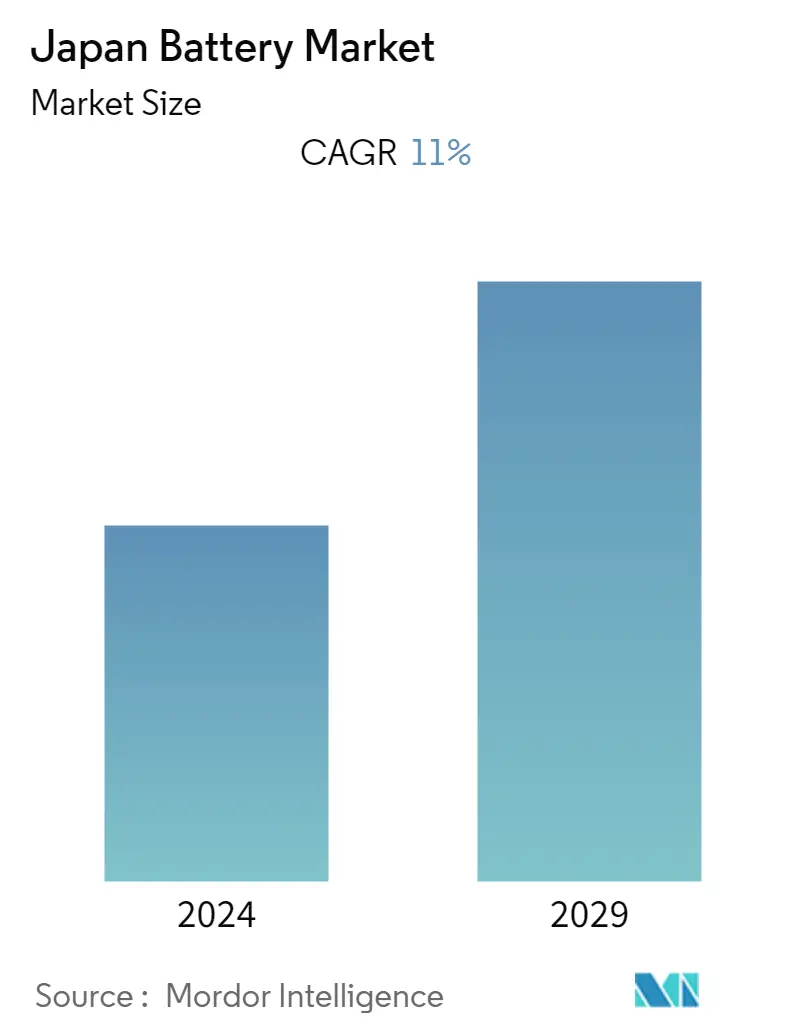
| Study Period | 2019 - 2029 |
| Base Year For Estimation | 2023 |
| Forecast Data Period | 2024 - 2029 |
| Historical Data Period | 2019 - 2022 |
| CAGR | 11.00 % |
| Market Concentration | Medium |
Major Players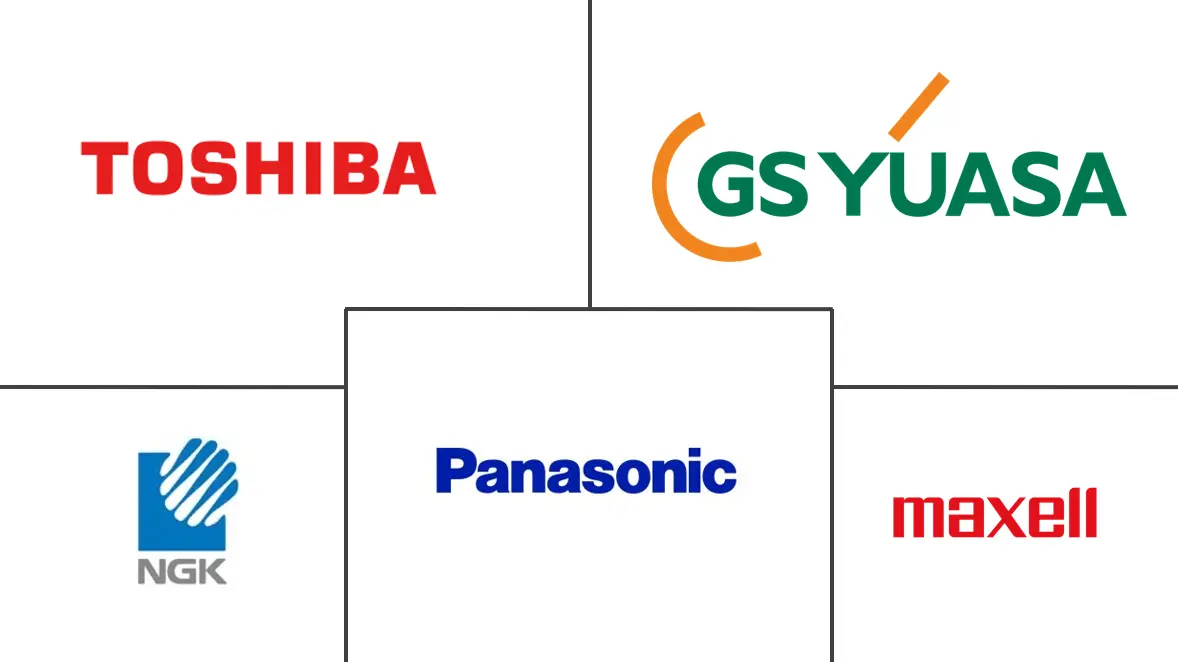
*Disclaimer: Major Players sorted in no particular order |
Need a report that reflects how COVID-19 has impacted this market and its growth?
Japan Battery Market Analysis
The Japan battery market is anticipated to register a CAGR of about 11% during the forecast period.
The outbreak of COVID-19 negatively impacted the market. Currently, the market has reached pre-pandemic levels.
- Factors such as the increasing adoption of electric vehicles, along with the increasing demand for consumer electronics and increasing renewable energy installations, are expected to drive the market.
- However, with the increasing demand for lithium-ion batteries, especially in electric cars, there is a substantial growth in mineral prices. In some cases, there is a shortage of mineral supply, which is likely to act as a restraint for the market growth during the forecast period.
- Advancements in the research and development of battery chemistries are expected to be a significant growth opportunity for the Japan Battery market in the future.
Japan Battery Market Trends
Secondary Battery Segment Expected to Dominate the Market
- In secondary batteries, electrode reactions are reversible, implying that applying an external voltage reconstructs the electrodes to their original state. Accordingly, secondary batteries act as both energy sources and energy storage systems. In general, secondary batteries have a low capacity and initial voltage, high self-discharge rates, and varying recharge life ratings. Moreover, these batteries are cost-efficient over the long term, even though individual batteries can be comparatively more expensive.
- Secondary batteries that are widely used in Japan include lead-acid batteries, alkaline storage batteries, and lithium-ion batteries.
- Lead-acid batteries are the most frequently used and available rechargeable batteries for various end-use applications, such as transportation, industrial, commercial, residential, and grid storage. However, due to stringent lead emission standards and benefits (such as cost advantages, lightweight, and ongoing improvements), lithium-ion batteries are increasingly deployed in high-drain applications, such as consumer electronics, battery energy storage systems, electric vehicles, and cordless electric power tools.
- However, lead-acid batteries are set to witness moderate growth in the secondary battery segment owing to their low specific energy, limited cycle life, and poor weight-to-energy ratio. The export value of rechargeable lead-acid batteries in Japan registered a considerable decline of more than 30%, from USD 128 million in 2018 to USD 83 million in 2021.
- The most popular secondary battery in Japan is the lithium-ion battery. It has a fast charging ability and offers longer life when compared to its counterparts. According to the Battery Association of Japan, sales of lithium-ion batteries for vehicles in terms of volume witnessed significant growth in recent years.
- The rising adoption of electric vehicles (EVs) across the country, coupled with a growing focus on climate change, is likely to create a positive business scenario for secondary battery manufacturers.
- By 2050, Japan aims to realize a 'Well-to-Wheel Zero Emission' policy, in line with the global efforts to eliminate emissions, with a focus on energy supply and vehicle innovation. Replacing all vehicles with EVs can reduce greenhouse gas emissions by around 80% per vehicle, including an approximate 90% reduction per passenger vehicle.
- Therefore, owing to the above points, the secondary battery segment is expected to dominate the Japanese market during the forecast period.
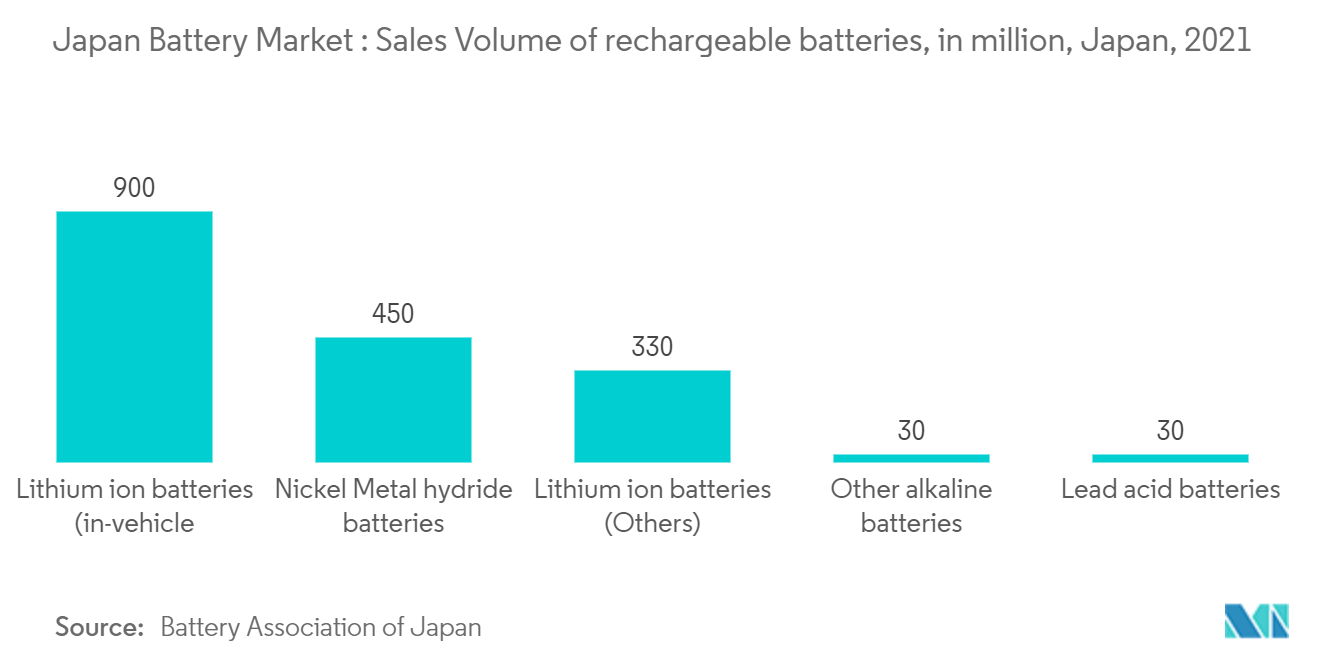
Increasing Renewable Energy Installations Expected to Drive the Market
- Japan is one of the largest renewable energy markets in the Asia-Pacific region. The country's renewable energy installed capacity reached 111.86 GW in 2021, representing an increase of over 4.67% compared to the previous year's value.
- Solar, hydro, wind, and bioenergy are the major renewable energy sources in the country. According to the BP statistical review of World Energy, in 2021, renewable energy sources accounted for approximately 12% of the total electricity generation mix and 6.6% of the primary energy mix in the country.
- Over the last decade, Japan's installed solar energy capacity has grown from 4.89 GW in 2011 to approximately 74 GW in 2021. However, the share of solar energy in the country's energy mix is still low. According to the BP Statistical Review of World Energy 2022, solar generation was 86.3 TWh in 2021, accounting for only about 8.5% of its total electricity generation.
- As solar energy is intermittent and unavailable at night, competent battery storage systems are necessary to properly utilize solar energy from rooftop photovoltaic (PV) and large-scale utility solar projects. Battery storage systems provide power during low and no sunlight hours and provide grid stability, preventing sudden voltage surges and sags.
- Japan is expected to become one of the global leaders in grid-connected battery storage projects, with several large-scale battery storage projects in the pipeline and under construction. For instance, in July 2022, a joint venture of Orix and Kansai Electric (KEPCO) announced that it would build and operate a large-scale battery storage system in western Japan. The project will have a capacity of 48MW/113MWh and will begin operation by 2024.
- In February 2022, the Ministry of Economy, Trade and Industry (METI) published the feed-in tariffs (FITs) that it proposes to apply to solar installations with a capacity of 10 to 250 kW, as well as the feed-in premiums (FIPs) to solar projects over 250 kW selected through the auction scheme in 2022. The ministry set a fixed FIT of USD 0.096/kWh for PV systems with capacities between 10 kW and 50 kW and a FIT of USD 0.087/kWh for installations between 50 kW and 250 kW. Thus, increasing renewable energy share in the country's energy mix is likely to drive the battery market in Japan for energy storage applications during the forecast period.
- Therefore, owing to the above points, increasing renewable energy installations fuelling the demand for battery energy storage systems, thus, in turn, driving the Japan battery market during the forecast period.
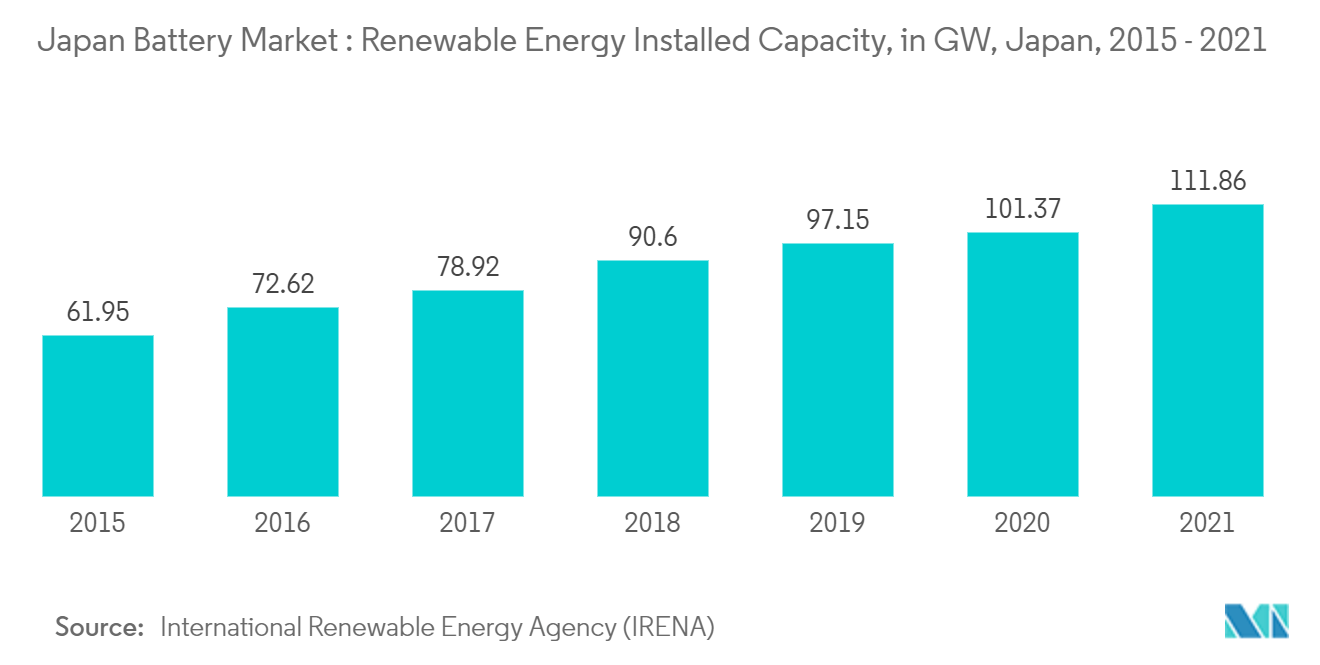
Japan Battery Industry Overview
The Japan battery market is fragmented. Some of the major players in the market (in no particular order) include Panasonic Corporation, Maxell, Ltd., GS Yuasa International Ltd, NGK Insulators Ltd., and Toshiba Corporation.
Japan Battery Market Leaders
Panasonic Corporation
GS Yuasa International Ltd
NGK Insulators Ltd.,
Toshiba Corporation
Maxell, Ltd.
*Disclaimer: Major Players sorted in no particular order
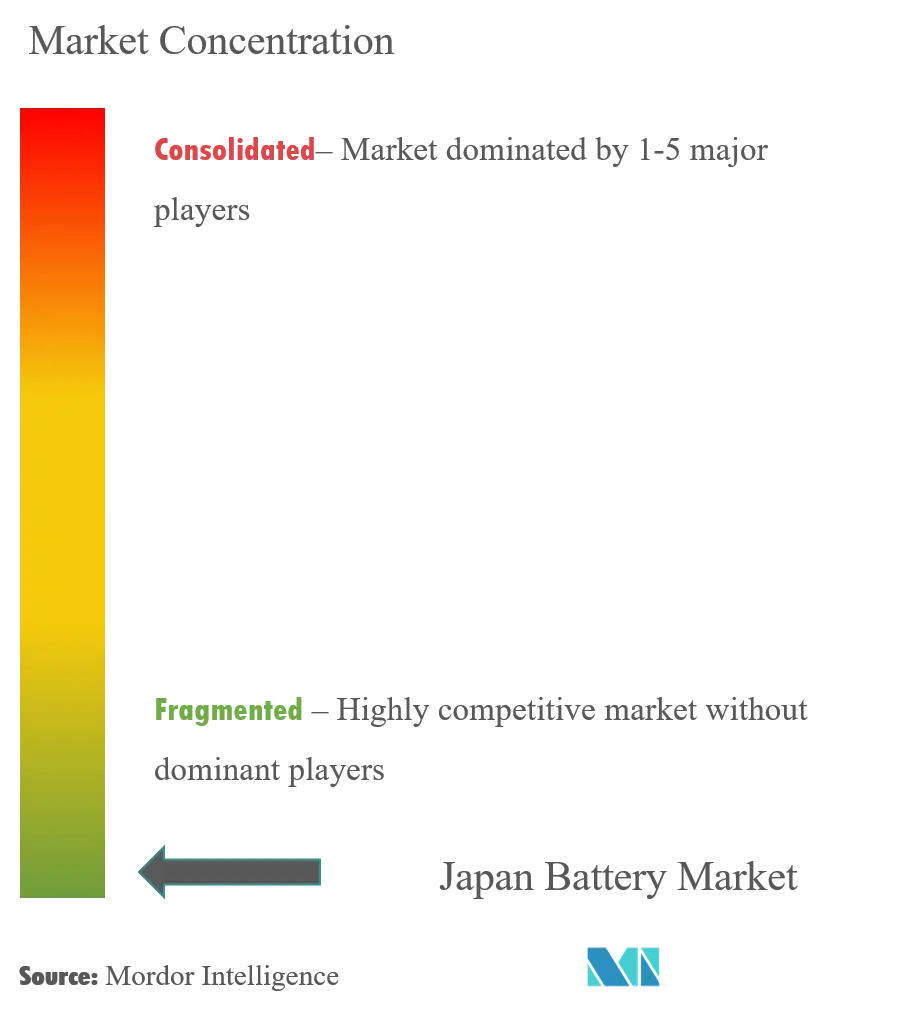
Japan Battery Market News
- February 2022: Panasonic announced that its Energy Company is likely to produce 4680 type cylindrical lithium-ion batteries in Japan in order to expand its business globally. The company is likely to establish a production facility at its Wakayama Factory in western Japan to manufacture 4680-type battery cells.
- November 2022: Eurus Energy Holdings Corp announced that the company established a grid storage battery business and started construction of a 1.5-MW/4.58-MWh project in the Fukuoka prefecture.
Japan Battery Market Report - Table of Contents
1. INTRODUCTION
1.1 Scope of the Study
1.2 Market Definition
1.3 Study Assumptions
2. EXECUTIVE SUMMARY
3. RESEARCH METHODOLOGY
4. MARKET OVERVIEW
4.1 Introduction
4.2 Market Size and Demand Forecast in USD billion, till 2028
4.3 Recent Trends and Developments
4.4 Government Policies and Regulations
4.5 Market Dynamics
4.5.1 Drivers
4.5.2 Restraints
4.6 Supply Chain Analysis
4.7 PESTLE Analysis
5. MARKET SEGMENTATION
5.1 Battery Type
5.1.1 Primary Battery
5.1.2 Secondary Battery
5.2 Technology
5.2.1 Lithium-ion Battery
5.2.2 Lead-Acid Battery
5.2.3 Others
5.3 Application
5.3.1 Automotive Batteries (HEV, PHEV, EV)
5.3.2 Industrial Batteries (Motive, Stationary (Telecom, UPS, Energy Storage Systems (ESS), etc.)
5.3.3 Portable Batteries (Consumer Electronics, etc.)
5.3.4 SLI Batteries
5.3.5 Others
6. COMPETITIVE LANDSCAPE
6.1 Mergers and Acquisitions, Joint Ventures, Collaborations, and Agreements
6.2 Strategies Adopted by Leading Players
6.3 Company Profiles
6.3.1 Panasonic Corporation
6.3.2 Maxell, Ltd.
6.3.3 GS Yuasa International Ltd
6.3.4 NGK Insulators Ltd
6.3.5 Toshiba Corporation
6.3.6 Contemporary Amperex Technology Co Ltd
6.3.7 LG Energy Solution
6.3.8 EEMB Battery
6.3.9 B & B Battery Co. Ltd,
6.3.10 Furukawa Battery Co. Ltd
- *List Not Exhaustive
7. MARKET OPPORTUNITIES AND FUTURE TRENDS
Japan Battery Industry Segmentation
A battery can be defined as an electrochemical device (consisting of one or more electrochemical cells) that can be charged with an electric current and discharged whenever required. Batteries are usually devices that are made up of multiple electrochemical cells that are connected to external inputs and outputs. The Japan battery market is segmented by battery type, technology, and application. By battery type, the market is segmented into primary battery and secondary battery. By application, the market is segmented into automotive batteries, industrial batteries, portable batteries, SLI batteries, and others. By technology, the market is segmented into lithium-ion batteries, lead-acid batteries, and others. For each segment, the market sizing and forecasts have been done based on revenue (USD billion).
| Battery Type | |
| Primary Battery | |
| Secondary Battery |
| Technology | |
| Lithium-ion Battery | |
| Lead-Acid Battery | |
| Others |
| Application | |
| Automotive Batteries (HEV, PHEV, EV) | |
| Industrial Batteries (Motive, Stationary (Telecom, UPS, Energy Storage Systems (ESS), etc.) | |
| Portable Batteries (Consumer Electronics, etc.) | |
| SLI Batteries | |
| Others |
Japan Battery Market Research FAQs
What is the current Japan Battery Market size?
The Japan Battery Market is projected to register a CAGR of 11% during the forecast period (2024-2029)
Who are the key players in Japan Battery Market?
Panasonic Corporation, GS Yuasa International Ltd, NGK Insulators Ltd., , Toshiba Corporation and Maxell, Ltd. are the major companies operating in the Japan Battery Market.
What years does this Japan Battery Market cover?
The report covers the Japan Battery Market historical market size for years: 2019, 2020, 2021, 2022 and 2023. The report also forecasts the Japan Battery Market size for years: 2024, 2025, 2026, 2027, 2028 and 2029.
Japanese Battery Industry Report
Statistics for the 2024 Japanese Battery market share, size and revenue growth rate, created by Mordor Intelligence™ Industry Reports. Japanese Battery analysis includes a market forecast outlook to 2029 and historical overview. Get a sample of this industry analysis as a free report PDF download.
